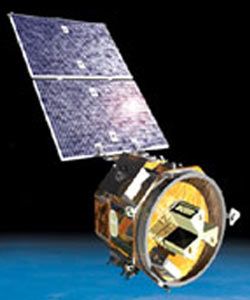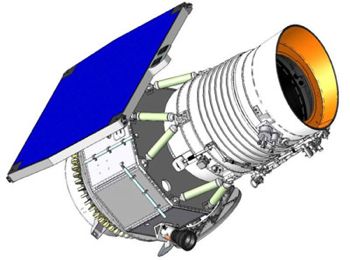
Home - Search - Browse - Alphabetic Index: 0- 1- 2- 3- 4- 5- 6- 7- 8- 9
A- B- C- D- E- F- G- H- I- J- K- L- M- N- O- P- Q- R- S- T- U- V- W- X- Y- Z
RS-300
 AIM Credit: Manufacturer Image |
AKA: AIM;NextSat;WISE;BCP-300. Status: Operational 2007. First Launch: 2007-03-09. Last Launch: 2009-12-14. Number: 3 . Gross mass: 150 kg (330 lb).
The low-risk spacecraft bus offered high performance in Earth or stellar pointing knowledge and control; data storage and transmission rates; available power; and payload mass fraction and volume. It was intended to fit on a Pegasus launch vehicle. The RS-300 design included Advanced Spacecraft Electronics (ASPEN) flight avionics developed for the Deep Impact comet impactor for the Jet Propulsion Laboratory (JPL).
The spacecraft also featured National Aeronautics and Space Administration (NASA) standard radio, and command and control data formats and interfaces to simplify operations and ground segment interfaces. The RS-300 provided 3-axis fine control and large, clear instrument fields of view. Its industry standard, single-board computer and non-volatile memory were complemented by custom electronics for communications interfaces, thermal control, sensor and actuator interfaces, and power control - all on a standard high speed backplane.
RS-300 avionics and software formed the core of the Orbital Express Advanced Technology Demonstration program, and the Widefield Infrared Survey Explorer (WISE).
More at: RS-300.
| NEXTSat/CSC Remote Servicing Technology satellite built by Ball Aerospace for DARPA, USA. Launched 2007. Used the RS-300 bus. |
| WISE( NEOWISE (MIDEX 6) Null |
| IXPE (SMEX 14) Null |
Family: Astronomy, Technology, Technology satellite. Country: USA. Launch Vehicles: Thor, Pegasus, Pegasus XL, Delta 7320-10, Atlas V, Atlas V 401, Delta 7320-10C. Launch Sites: Cape Canaveral, Vandenberg, Vandenberg SLC2W, Cape Canaveral LC41, Point Arguello WADZ. Agency: Ball. Bibliography: 2, 6835, 13033, 13034.
 | NextSat Credit: Manufacturer Image |
 | WISE Credit: Manufacturer Image |
2007 March 9 - . 03:10 GMT - . Launch Site: Cape Canaveral. Launch Complex: Cape Canaveral LC41. Launch Pad: SLC41. LV Family: Atlas V. Launch Vehicle: Atlas V 401.
- NextSat - . Mass: 250 kg (550 lb). Nation: USA. Agency: DARPA. Manufacturer: Ball. Class: Technology. Type: Rendezvous technology satellite. Spacecraft: RS-300. USAF Sat Cat: 30774 . COSPAR: 2007-006C. Apogee: 498 km (309 mi). Perigee: 491 km (305 mi). Inclination: 46.00 deg. Period: 94.50 min. The passive satellite portion of DARPA's Orbital Express satellite servicing experiment. NextSat carried hydrazine for fluid transfer experiments, but no propulsion system. Attitude was controlled by momentum wheels supplemented by magnetic torquer rods..
2007 April 25 - . 20:26 GMT - . Launch Site: Point Arguello. Launch Complex: Point Arguello WADZ. Launch Pad: Aircraft from Vandenberg.. Launch Platform: L-1011. LV Family: Pegasus. Launch Vehicle: Pegasus XL.
- AIM - .
Mass: 150 kg (330 lb). Nation: USA.
Agency: Hampton,
NASA.
Manufacturer: Ball,
OSC.
Spacecraft: RS-300.
USAF Sat Cat: 31304 . COSPAR: 2007-015A. Apogee: 602 km (374 mi). Perigee: 584 km (362 mi). Inclination: 97.80 deg. Period: 96.50 min.
NASA Small Explorer mission, for Aeronomy of Ice in the Mesosphere. AIM carried three scientific instruments to study polar mesospheric clouds: a solar occultation camera, an ultraviolet imager, and a cosmic dust experiment. Air dropped in Point Arguello WADZ.
2009 December 14 - . 14:09 GMT - . Launch Site: Vandenberg. Launch Complex: Vandenberg SLC2W. LV Family: Thor. Launch Vehicle: Delta 7320-10C.
- WISE - .
Mass: 674 kg (1,485 lb). Nation: USA.
Agency: Martin.
Class: Astronomy.
Type: Infrared astronomy satellite. Spacecraft: RS-300.
USAF Sat Cat: 36119 . COSPAR: 2009-071A. Apogee: 532 km (330 mi). Perigee: 527 km (327 mi). Inclination: 97.50 deg. Period: 95.20 min.
Wide Field Infrared Explorer astronomy satellite, designed to conduct an all-sky survey at infrared frequencies of 3.4, 4.6, 12 and 22 microns, detecting objects 100 times fainter than the earlier IRAS and Akari satellites. Primary instrument is a 40 cm telescope cooled to 12 K by a cryostat filled with solid hydrogen. The survey was expected to detect tens of thousands of new asteroids, brown dwarf stars, and planets orbiting nearby stars.
Back to top of page
Home - Search - Browse - Alphabetic Index: 0- 1- 2- 3- 4- 5- 6- 7- 8- 9
A- B- C- D- E- F- G- H- I- J- K- L- M- N- O- P- Q- R- S- T- U- V- W- X- Y- Z
© 1997-2019 Mark Wade - Contact
© / Conditions for Use